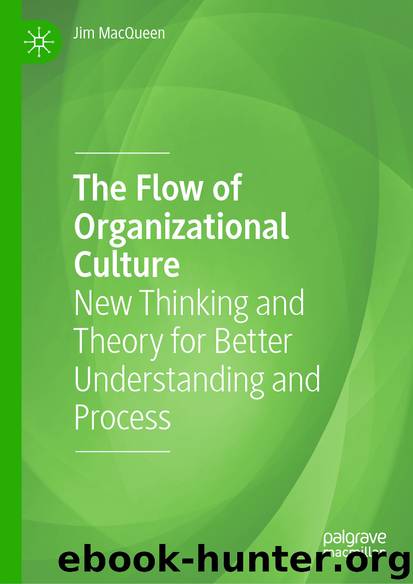The Flow of Organizational Culture by Jim MacQueen

Author:Jim MacQueen
Language: eng
Format: epub
ISBN: 9783030256852
Publisher: Springer International Publishing
In other words, we learn and apply approach and avoidance behaviors and lessons based on memories of past action. We apply these ideas prospectively to what we anticipate may come as a result of actions in which we may or may not choose to engage. That choice, when it is processed and agreed upon by a group, is often turned into a kind of principle that is applied to a particular action or class of actions more generally. This enables them to say, “because we know that such and such an activity results in a certain kind of outcome, on principle, we do not engage in that activity”.
If this agreement persists in the group over time, we often refer to it as a “value” that is held by the group. Values are something that both practitioners and scholars refer to as key component pieces of organizational culture (Cameron & Quinn, 2011; Deal & Kennedy, 1982/2000; Hatch, 1993; Martin, 2002; Schein, 2017). What is important to note here is that values can and do arise from the spontaneous interactions of the group and are not necessarily dependent on their introduction and reinforcement by leaders. Not that values reinforcement by leaders are not important. It can be critically important for the development of a culture. But leadership, while important, is not the sole source of values in an organization. As we have just seen, values may be spontaneously generated out of a group’s experience. This is often the case for much of what comes to constitute an organization’s culture. For successful construction and shaping of culture, it is imperative that both leaders and consultants stay extremely aware of these kinds of activity and stand ready to reinforce or discourage them as may be desirable and necessary.
3. Enactive of Sensible Environments. The first of several questions to be answered in this section is, what does Weick mean by the heading, “Enactive of Sensible Environments”? Weick (1995) has anticipated this question, at least with regard to the idea of enactive: “I use the word enactment to preserve the fact that, in organizational life, people often produce part of the environment they face (Pondy & Mitroff, 1979, p. 17)” (Weick, p. 30). Weick provides several examples of what he might mean by invoking more common forms of the verb to enact. He talks about legislators enacting laws and managers who often apply or enact policy. “Both groups construct reality through authoritative acts” (1995, p. 30). What this comes down to is the idea that we are creating, or constructing, our own realities through our ideas and actions. In this case, we do this by taking some idea that we have produced in the course of sensemaking, such as a vision, a plan, or a value, incorporating it into the mental model of our context and/or organization, and reifying it. (This is also known as social constructionism.)
By “sensible,” I take him to be using a root form of the word which means that something is able to be perceived by the senses or the mind.
Download
This site does not store any files on its server. We only index and link to content provided by other sites. Please contact the content providers to delete copyright contents if any and email us, we'll remove relevant links or contents immediately.
The Black Swan by Nassim Nicholas Taleb(6761)
Bad Blood by John Carreyrou(6271)
Pioneering Portfolio Management by David F. Swensen(6078)
Millionaire: The Philanderer, Gambler, and Duelist Who Invented Modern Finance by Janet Gleeson(4089)
Skin in the Game by Nassim Nicholas Taleb(3965)
The Money Culture by Michael Lewis(3843)
Bullshit Jobs by David Graeber(3826)
Skin in the Game: Hidden Asymmetries in Daily Life by Nassim Nicholas Taleb(3720)
The Wisdom of Finance by Mihir Desai(3523)
Blockchain Basics by Daniel Drescher(3327)
Liar's Poker by Michael Lewis(3220)
The Intelligent Investor by Benjamin Graham Jason Zweig(2930)
Hands-On Machine Learning for Algorithmic Trading by Stefan Jansen(2925)
Mastering Bitcoin: Programming the Open Blockchain by Andreas M. Antonopoulos(2890)
Fooled by Randomness: The Hidden Role of Chance in Life and in the Markets by Nassim Nicholas Taleb(2860)
Investing For Dummies by Eric Tyson(2790)
The Power of Broke by Daymond John(2769)
Market Wizards by Jack D. Schwager(2538)
Zero Hour by Harry S. Dent Jr. & Andrew Pancholi(2531)
